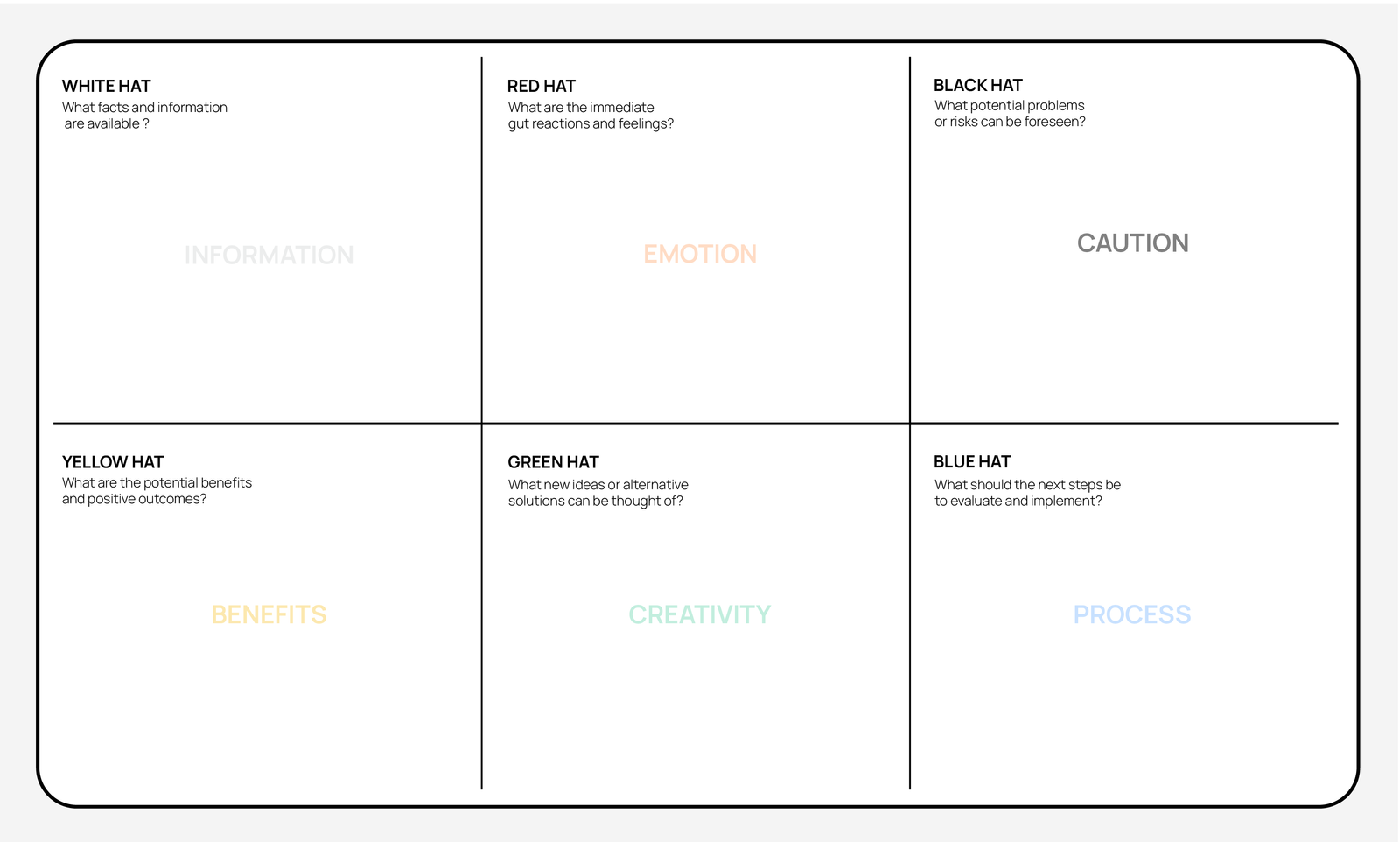Six Thinking Hats
The Six Thinking Hats is a tool used in group settings to divide thinking into six parts to help see a subject or problem from multiple perspectives. Each type of thinking is represented by a coloured hat, that are ‘worn’ by participants throughout a discussion.
Concepts important in using the Six Thinking Hats:
Blue Hat: Focuses on the thinking process and ensuring other hats are being used correctly. The view of control.
Red Hat: Focuses on intuition and feelings. The emotional view.
Black Hat: Focuses on identifying risks, barriers and potential issues. The serious and cautious view.
White Hat: Focuses on facts and objective information. The neutral and objective view.
Green Hat: Focuses on creative thinking and growth. The abundant and innovative view.
Yellow Hat: Focuses on positivity and identifying benefits. The optimistic and hopeful view.
The results
- A deeper understanding of a problem or situation
- Team alignment about the problem or situation

When to use it
Meeting Facilitation: When structuring a meeting to encourage fresh thinking and ideas
Problem Solving: When seeking to solve problems
Conflict Resolution: When seeking to align different perspectives
Strengths
Encourages equal participation
Simple
Structured
Widely known
Weaknesses
Less suitable for people who prefer unstructured discussion
Participants can resist some aspects
Prone to mis-use
How to use it?
What do I need to start?
- A problem definition or succinct explanation of the situation.
- Insights related to the problem.
- Materials to visually represent the hats during sessions (optional)
How to use it?
Who to involve?
The Six Thinking Hats is best done with a team. Consider involving:
- People who can make decisions about the problem
- People who are able to challenge assumptions and offer fresh thinking
Step by step
1
Determine the approach
Good practice would include:
- Participants all thinking with the same hat colour in turn, and are given an equal amount of time to contribute their ideas. For example, if there are five participants, then five minutes may be allocated to each hat so each participant can speak wearing each hat for one minute.
- Making a plan for the sequence of hats to be used.
- Getting participants up to speed by explaining the six different thinking styles represented by the different hats.
- Planning for individual reflection between hat swaps.
2
Facilitate the discussion
Start with the facilitator using the blue hat and outline:
- The definition of the situation or problem
- What the group is aiming to achieve
- Relevant background and context
Rotate through each of the hats, focussing on generating thoughts and ideas about the problem or situation.
White hat
Avoid opinions or interpretations and keep to the facts. Ask questions like:
What information do we have and what is missing?
What questions do we need to ask?
What facts need to be shared?
How will we get the information we need?
Red hat
Explore emotions, feelings, hunches, intuitions and impressions. Avoid justifying or giving reasons for a feeling or thought. Ask questions like:
What is your gut reaction?
What emotions are coming up during this discussion?
What instinctual concerns or hopes are you feeling?
Black hat
Explore risks and dangers with caution. Ask questions like:
What are the potential risks?
Why might this not work?
What are the issues or weaknesses?
What is likely to happen in the future, and what could go wrong?
Yellow hat
Explore possibilities and suggestions, with a focus on optimism. Speculate on the best possible outcome and encourage positive assessments. Ask questions like:
What are the benefits?
What is the best case scenario?
How can we maximise positive impact?
Green hat
Put creative thinking skills to the test and search for alternatives. Avoid judgement and focus on moving forward with ideas. Ask questions like:
What new ideas can we explore?
What approaches haven’t we considered?
How can we turn obstacles into opportunities?
Blue hat
Use the blue hat to ‘think about thinking.’ Ask questions like:
What are we trying to achieve?
What alternatives are there to the problem definition?
What is the most important question for us to explore?
What approach do we want to use solve this problem or tackle this situation?
3
Review and conclude
Finish with the blue hat.
Step through the implications of each solution or idea presented.
Analyse and make decisions based on the discussion.
Summarise what was achieved, which may include decisions, solutions reached and next steps.